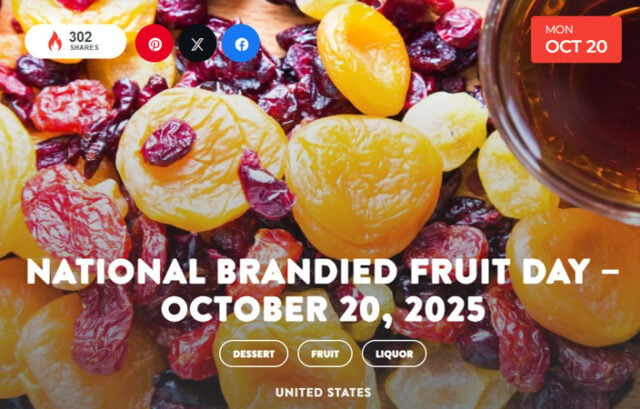
On October 20 each year, we celebrate the delicious food holiday known as National Brandied Fruit Day!
Brandied fruit is the perfect snack for those who want something spicy along with the delicious sweetness of fruits. You get your fill of alcohol as well as the healthy nutrients of fruits.
- 1313 – Brandy is distilled as medicine in France because of its extraordinary sanitary and strengthening powers.
- 1600s – Some of the earliest thermometers contained brandy instead of mercury.
- 1780 – America’s oldest distiller, Robert Liard, records his first commercial transaction of Applejack at his distillery in New Jersey.
- 1797 – George Washington, who begins distillation operations at the advice of his farm manager, becomes one of the biggest commercial distillers in America.
- mid-1800s – Brandy, during the Victorian era of 1820–1914, is discovered to be a preservative for fruits, and soon becomes a popular dessert because mixing it with fruits enhances its taste.
- Brandied fruit became popular around the Victorian era. It was the easiest way to make fruit last longer. Incidentally, this process was also a great way to harvest the taste of fruit, while creating a delicious dessert for adults.
- Interestingly, brandied fruit is used as a starter for Friendship Cake. Similar to the concept of a starter for sourdough bread, Friendship Cake takes time to prepare.
- Brandied fruit is used as a topping on pies.
- Brandy is distilled from fruits such as grapes, apples, blackberries, apricots, and so on.
- Based on the region and the fruit, brandy can be divided into several categories: Cognac, Armagnac, American Brandies, and fruit brandies.
- The word brandy originally comes from the Dutch word brandewijn, which means burnt wine.
- Long before the 16th century, wine was a popular product for trading in the European region. In the early 16th century, a Dutch trader invented a way to ship more wine in the limited cargo space by removing water from the wine. Then he could add the water back to the concentrated wine at the destination port in Holland.
- Most brandy is 80-proof (40% alcohol/volume) and has been enjoyed for centuries as a cocktail and cooking ingredient.
- Cognac and Armagnac are both French brandies made from white wine grapes.
- American brandies are mostly distilled in California, where the grape grows. According to U.S. law, American brandies must be aged for at least 2 years in wood.
- Brandy has a traditional age grading system, although its use is unregulated outside of Cognac and Armagnac. These indicators can usually be found on the label near the brand name: VS, VSOP, XO, and Hors d’âge.
- VS stands for “Very Special”: only eaux-de-vie at least two years old can be used to make a VS cognac. Other denominators and expressions are permitted, such as “3 stars” or “luxury”, and as such are included in the VS cognac category.
- VSOP stands for “Very Superior Old Pale”: VSOP cognacs are created from eaux-de-vie aged for at least four years. The VSOP category includes designations such as “Old” or “Reserve”.
- XO stands for “Extra Old”: XO cognacs are made only from eaux-de-vie at least six years old. Cognacs such as “Napoleon” or “Old Reserve” are equivalent to XO cognac.
- Hors d’âge (literally meaning Beyond Age) is a designation that BNIC states is equal to XO, but in practice, the term is used by producers to market a high-quality product beyond the official age scale.
- Brandy has many health benefits, such as increasing the strength of the immune system, reducing respiratory issues, controlling weight issues, improving sleep patterns, treatment for pneumonia, boosting heart health, and treating certain types of cancer and it has the ability to slow the signs of aging.
- During aging, evaporation contributes to the progressive reduction of the alcohol level. It varies with storage conditions but averages 2% per year. This is called “The angels’ share.”
- The largest collection of brandy is 1057 bottles, achieved by Manuel Bru Vicente (Spain), in Elche, Alicante, Spain, as confirmed on 1 January 2017.
Sources:
Disclaimer
The information contained in South Florida Reporter is for general information purposes only.
The South Florida Reporter assumes no responsibility for errors or omissions in the contents of the Service.
In no event shall the South Florida Reporter be liable for any special, direct, indirect, consequential, or incidental damages or any damages whatsoever, whether in an action of contract, negligence or other tort, arising out of or in connection with the use of the Service or the contents of the Service. The Company reserves the right to make additions, deletions, or modifications to the contents of the Service at any time without prior notice.
The Company does not warrant that the Service is free of viruses or other harmful components












